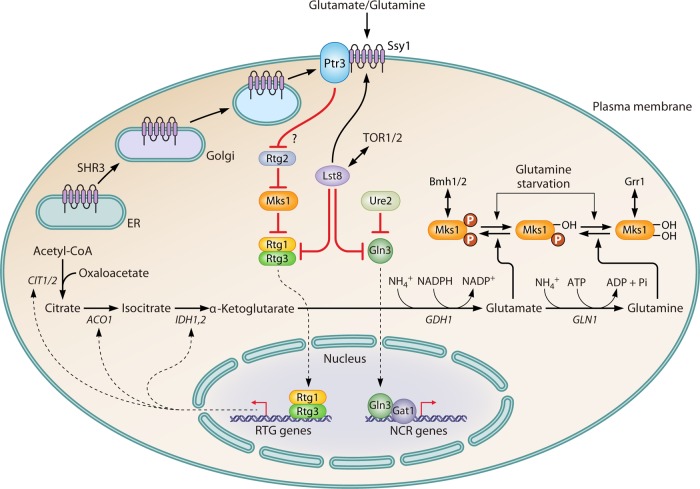FIG 6.
Influence of the RTG pathway on nitrogen metabolism. When preferred nitrogen sources, such as glutamate or glutamine, are present in the environment, the inhibitory signal of the RTG pathway is generated from the interaction between glutamine or glutamate and Ssy1. The inhibitory signal is transduced to Rtg2 via Ptr3 in an unknown manner, thereby preventing Rtg2 from binding to Mks1, which allows Mks1 to interact with Rtg1/3 and retain them in the cytoplasm. The cytosolic sequestration of Rtg1/3 represses the transcription of RTG genes, including genes such as CIT1/2, ACO1, and IDH1,2, which are involved in converting oxaloacetate to α-ketoglutarate in the TCA cycle. This repression decreases the concentration of intracellular α-ketoglutarate, the precursor of glutamate and glutamine, and it finally decreases the levels of intracellular amino acids. The presence of glutamate or glutamine activates the TOR pathway, which interplays with Lst8 to regulate both the RTG and NCR pathways. Lst8 represses the RTG pathway at two levels. The first is by influencing the targeting or assembly of the SPS sensor system or its signal transduction function. The second is by inhibiting Rtg1/3 from translocating to the nucleus to activate the transcription of RTG genes. For the NCR pathway, Lst8 prevents Gln3 from translocating into the nucleus to activate the transcription of NCR genes. Mks1 is a multiply phosphorylated protein. Glutamate promotes the hyperphosphorylation of Mks1, which correlates with strong repression of the RTG pathway. When ammonia or glutamine is provided, Mks1 shifts to an intermediate state of phosphorylation. In the presence of the former, rapamycin treatment, which causes only partial dephosphorylation of Mks1, cannot dephosphorylate Mks1 to the point that the dephosphorylation level crosses the threshold required for the derepression of the RTG pathway. Additionally, Mks1 still binds with Bmh1/2 to repress Rtg1/3. In the presence of glutamine, rapamycin treatment dephosphorylates Mks1, which is sufficient to release it from the Mks1-Bmh1/2 complex to derepress the RTG pathway and to interact with Grr1, which enables it to enter the degradation pathway.

